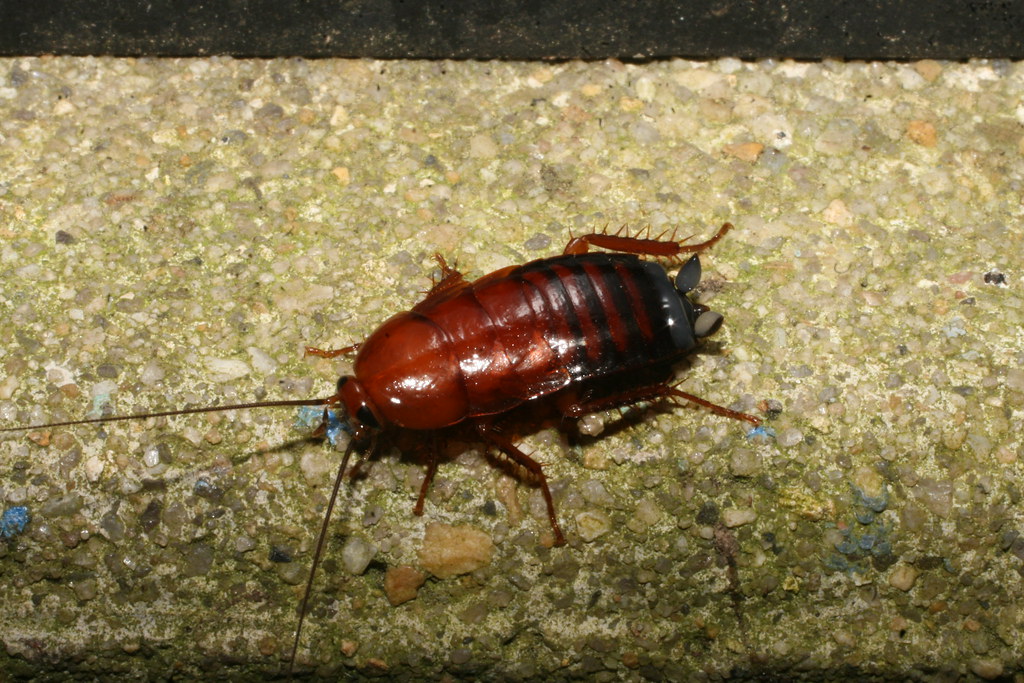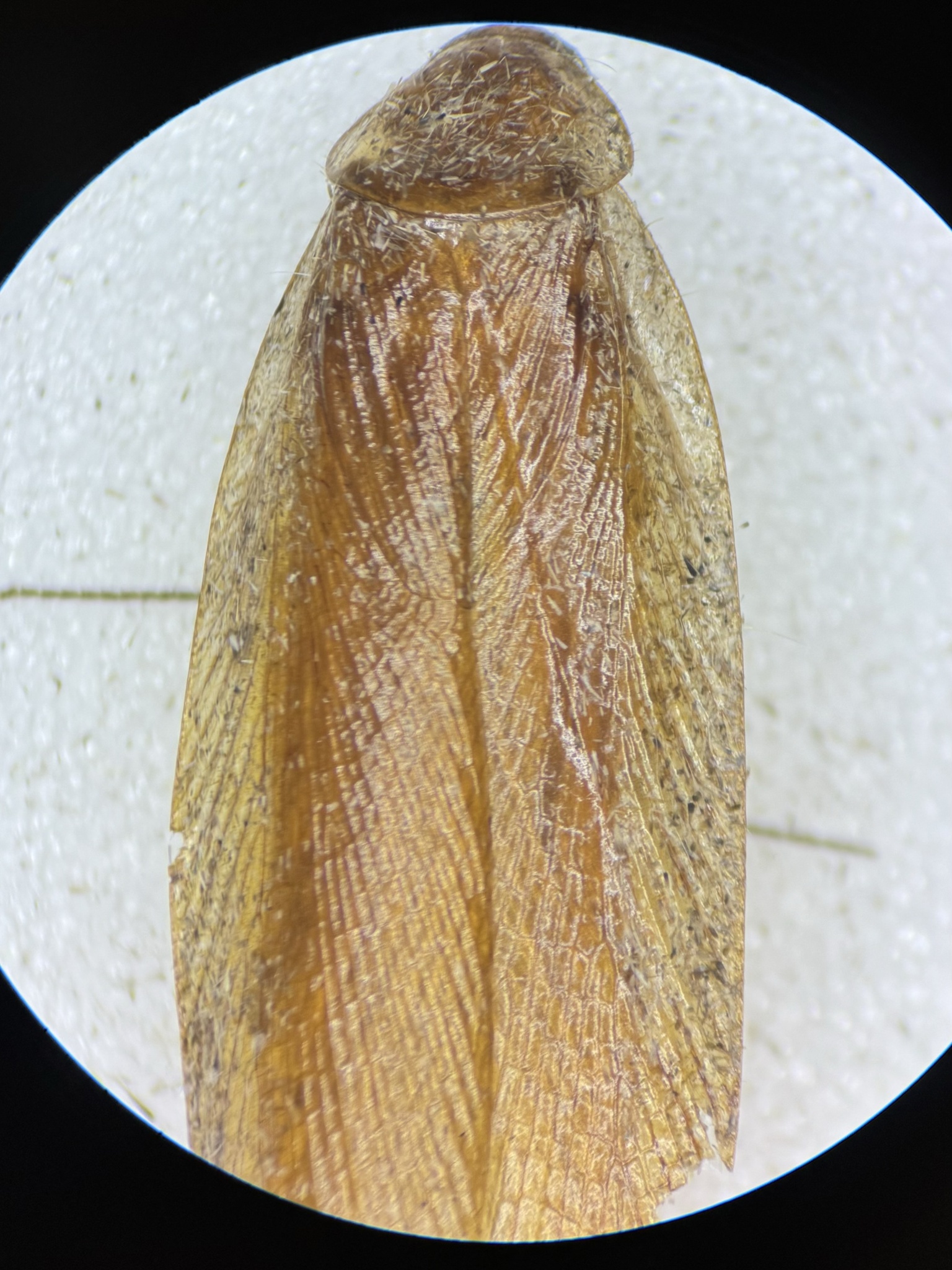Map Snapshot



2 Records
Seasonality Snapshot
Source: Wikipedia
| Parcoblatta lata | |
|---|---|

| |
| Parcoblatta lata | |
| Scientific classification | |
| Domain: | Eukaryota |
| Kingdom: | Animalia |
| Phylum: | Arthropoda |
| Class: | Insecta |
| Order: | Blattodea |
| Family: | Ectobiidae |
| Genus: | Parcoblatta |
| Species: | P. lata
|
| Binomial name | |
| Parcoblatta lata (Brunner von Wattenwyl, 1865)
| |
| Synonyms | |
Parcoblatta lata, the broad wood cockroach, is a species of wood cockroach (family Ectobiidae) native to the United States.[2] It is one of the largest species of wood cockroaches.[3]
Description
[edit]Both genders of P. lata are relatively large and robust for the genus.[4] The male dorsal coloration of the species is a glossy light brown or reddish brown, while the female is a darker brown.[5] The male's tegmina (outer forewings) extend well beyond the abdomen, and are wider than its pronotum.[4] The female's short tegmina end around the second dorsal segment, and are colored slightly lighter than the rest of the body.[4][5] The female is wider than the male,[5] and has a much larger, more rounded pronotum.[6]
| Male[4] | Female[4] | |
|---|---|---|
| Body length | 17.5–21.5 mm (0.69–0.85 in) | 15.7–22.0 mm (0.62–0.87 in) |
| Pronotum length | 4.1–5.2 mm (0.16–0.20 in) | 4.8–6.2 mm (0.19–0.24 in) |
| Pronotum width | 5.4–6.7 mm (0.21–0.26 in) | 6.7–8.2 mm (0.26–0.32 in) |
| Tegmina length | 17.8–22.0 mm (0.70–0.87 in) | 5.9–8.0 mm (0.23–0.31 in) |
| Tegmina width | 5.2–6.8 mm (0.20–0.27 in) | 4.7–5.7 mm (0.19–0.22 in) |
The ootheca typically measures around 4 mm × 9 mm (0.16 in × 0.35 in), with its seam slightly curved, having a row of about 30 evenly spaced knobs.
Distribution
[edit]The distribution of the species is the Eastern United States, including Alabama, the District of Columbia, Delaware, Florida, Georgia, Illinois, Indiana, Iowa, Kansas, Kentucky, Louisiana, Maryland, Mississippi, Missouri, North Carolina, Oklahoma, South Carolina, Tennessee, Texas, and Virginia.[7]
Mating behavior
[edit]As with many cockroaches, the female Parcoblatta lata emits pheromones to find mates, a process termed calling.[8] It assumes a characteristic calling posture by alternately raising its body upward from the ground by bending its body longitudinally, and lowering it downward by straightening its body.[8] P. lata produces volatile, long-distance pheromones, attracting the males which can fly to the female's location. The 12 species of the genus Parcoblatta are theorized to produce species-specific blends of pheromones, although there may be other species-isolating mechanisms of attraction such as time or location.[3] A main component of the pheromones of P. lata is an unusual lactone, (4Z,11Z)-oxacyclotrideca-4,11-dien-2-one.[3][9] Discovered in 2011 and dubbed Parcoblattalactone, it is also found in other species of the genus Parcoblatta, and a synthetic version has been created for use in assessing Parcoblatta populations.[3]
Habitat and ecology
[edit]P. lata commonly inhabit forests and grasslands.[10] They are endemic to pine forests of the southeastern US,[3] have been found in grassland and shrub communities in Kansas,[7] and have been found only in lowlying mesic hammocks in Florida.[7][8]
The species has been reported indoors, at lights, and under wooden signs on trees.[11]
In an observational study of the species, it was observed to eat cambium, flower petals, and sap.[8] A survey of insects caught by the pitcher plant Saracenia flava included male specimens of four species of Parcoblatta, including P. lata, leading to speculation that the winged adults may seek nectar as a source of energy for flying.[8]
It is a methanogenic (methane-producing) species, a trait more common in the cockroach families Blaberidae and Blattinae than in the family Blatellidae.[12]
The species comprises more than half the biomass of the diet of the endangered red-cockaded woodpecker (Picoides borealis).[3]
Additional Images
[edit]-
Parcoblatta lata nymphs
-
Parcoblatta virginica on top of a Parcoblatta lata. From the head to the tip of the wings the Parcoblatta lata measured 25 millimeters long and the Parcoblatta virginica 14 millimeters long.
-
Photo showing the difference in size between Parcoblatta lata and Parcoblatta virginica adult males.
-
Adult female
-
Underside of adult female
-
A group of adult females.
References
[edit]- ^ a b c "Synonyms of broad wood cockroach (Parcoblatta lata)". Encyclopedia of Life. Retrieved 2014-03-22.
- ^ Beccaloni, GW (2007). "species Parcoblatta lata (Brunner von Wattenwyl, 1865)". Blattodea Species File Online. Retrieved 2014-03-20.
- ^ a b c d e f Eliyahu, D.; Nojima, S.; Santangelo, R. G.; Carpenter, S.; Webster, F. X.; Kiemle, D. J.; Gemeno, C.; Leal, W. S.; Schal, C. (2011). "Unusual macrocyclic lactone sex pheromone of Parcoblatta lata, a primary food source of the endangered red-cockaded woodpecker". Proceedings of the National Academy of Sciences. 109 (8): E490 – E496. doi:10.1073/pnas.1111748109. ISSN 0027-8424. PMC 3286908. PMID 22184232.
- ^ a b c d e Blatchley, Willis Stanley (1920). Orthoptera of northeastern America: with especial reference to the faunas of Indiana and Florida. The Nature Publishing Company. pp. 84–85.
- ^ a b c Papp, Charles S. (2001). A comprehensive guide to North American insects: with notes on other arthropods of health importance. Gilbert Industries, Inc. p. 41. ISBN 978-0-937975-01-5.
Male glossy light brown dorsally and much narrower than the darker-brown female; the short wings of the latter slightly lighter in color than the rest of the body. 15.5-22.0 mm. Under loose bark of pine. Occasionally numerous.
- ^ Marcovitch, S (1920). Bulletin No. 33: Grasshoppers of Tennessee. Vol. 9. Knoxville, Tennessee: Tennessee State Board of Entomology. p. 27.
- ^ a b c Atkinson, Thomas H.; Koehler, Philip G.; Patterson, Richard S. (1990). "Annotated checklist of cockroaches of Florida (Dictyoptera: Blattaria: Blattidae, Polyphagidae, Blattellidae, Blaberidae)" (PDF). Florida Entomologist. 73 (2): 317. doi:10.2307/3494816. JSTOR 3494816.
- ^ a b c d e Bell, WJ; Roth, LM; Nalepa, CA (2007). Cockroaches: Ecology, Behavior, and Natural History. JHU Press. pp. 7–8, 38, 64, 68, 91. ISBN 978-0-8018-8616-4.
- ^ Wyatt, Tristram D. (14 February 2014). Mucignat-Caretta, Carla (ed.). Introduction to chemical signaling in vertebrates and invertebrates. CRC Press. p. 9. ISBN 978-1-4665-5341-5. PMID 24830039.
{{cite book}}:|work=ignored (help) - ^ Slobodchikoff, C. N. (1988). The Ecology of social behavior. Academic Press. p. 340. ISBN 978-0-12-648781-7.
- ^ Robinson, William H. (14 April 2005). Urban Insects and Arachnids: A Handbook of Urban Entomology. Cambridge University Press. p. 49. ISBN 978-0-521-81253-5.
- ^ König, Helmut; Varma, Ajit (27 January 2006). Intestinal Microorganisms of Termites and Other Invertebrates. Springer. pp. 160–161. ISBN 978-3-540-28185-6.







